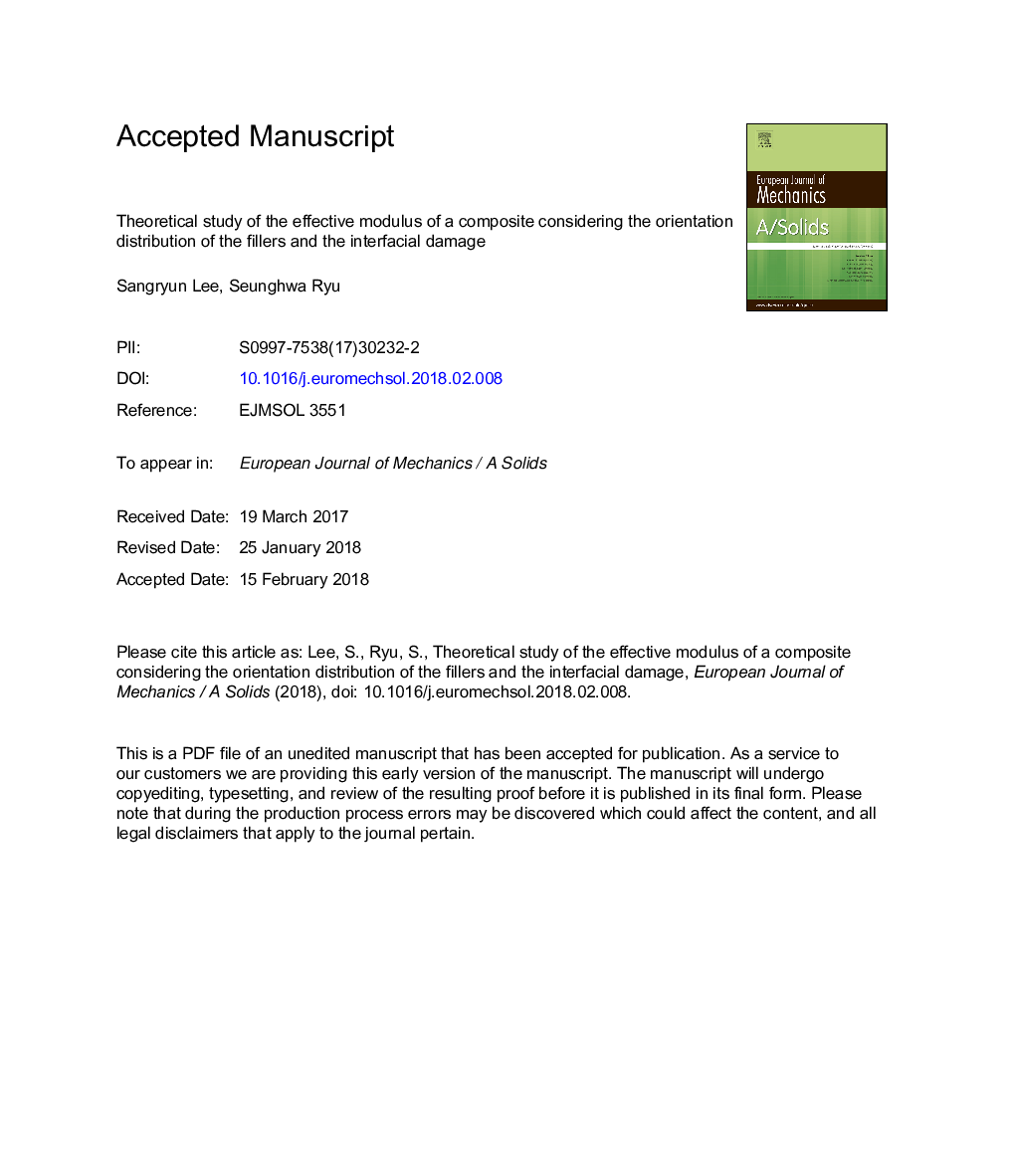| کد مقاله | کد نشریه | سال انتشار | مقاله انگلیسی | نسخه تمام متن |
|---|---|---|---|---|
| 7170050 | 1463175 | 2018 | 35 صفحه PDF | دانلود رایگان |
عنوان انگلیسی مقاله ISI
Theoretical study of the effective modulus of a composite considering the orientation distribution of the fillers and the interfacial damage
ترجمه فارسی عنوان
بررسی نظری مدول موثر یک کامپوزیت با توجه به توزیع جهت گیری پرکننده ها و آسیب بین فضایی
دانلود مقاله + سفارش ترجمه
دانلود مقاله ISI انگلیسی
رایگان برای ایرانیان
کلمات کلیدی
یکسان سازی، میکرومکانیک، میانگین جهت، خسارت متقابل،
ترجمه چکیده
در فرایند تولید یک کامپوزیت تقویت کننده پرکننده، پرکننده ها بخاطر جریان برش در مرحله رسم، بخشی هستند. علاوه بر این، نقایص مختلف در رابط بین ماتریس و پرکننده ایجاد می شود، که منجر به عقب انداختن و لغزش تحت بارگذاری مکانیکی می شود. مطالعات میکرومکانیکی متعددی برای پیش بینی ماژول های موثر کامپوزیت ها در حضور تراز جزئی پرکننده ها و نقص های رابط وجود دارد. در اینجا، ما تئوری بهبود یافته را ارائه می دهیم که دو محدودیت را در رویکردهای موجود مبتنی بر میکرومکانیک برطرف می کند. اولا، ما دریافتیم که تانسور آسیب رابط برای تقارن ناهمگام محور ناهمواری ایجاد شده برای مدل سازی آسیب بین فضایی منجر به پیش بینی مدول مؤثر بی نهایت یا منفی می شود. ما نشان می دهیم که اگر این تضاد به درستی حاصل شود، این ناهنجاری ها می توانند از بین بروند. دوم، ما نشان می دهیم که نظریه قبلی در مورد مؤلفه موثر با توزیع جهت گیری پر کننده محور ناکام است، زیرا پیش بینی های مدول طولی و عرضی در حد توزیع جهت گیری تصادفی همگرایی نیست. با اصلاحات مناسب، عبارات تحلیلی را برای میانگین جهت گیری تانسور مرتبه چهارم مرتبه ایثروتپاکی دلخواه تحت توزیع جهت عمودی محور به دست می آوریم. ما روش بهبود یافته برای محاسبه مؤلفه موثر یک کامپوزیت نانولوله کربنی پلیمر-کربن با جهت گیری نازک یکنواخت و آسیب رابط را اعمال می کنیم.
موضوعات مرتبط
مهندسی و علوم پایه
سایر رشته های مهندسی
مهندسی مکانیک
چکیده انگلیسی
In the manufacturing process of a filler-reinforced composite, the fillers are partially aligned due to the shear flow in the drawing stage. Besides, various imperfections form at the interface between the matrix and the fillers, leading to debonding and slip under mechanical loading. There have been numerous micromechanics studies to predict effective moduli of the composites in the presence of partial alignment of fillers and interface imperfections. Here, we present an improved theory that overcomes two limitations in the existing micromechanics based approaches. First, we find that the interface damage tensor for axisymmetric ellipsoidal inhomogeneity developed to model the interfacial damage leads to the prediction of infinite or negative effective moduli. We show that these anomalies can be eliminated if correctly derived damage tensor is used. Second, we reveal that the previous theory on the effective moduli with axisymmetric filler orientation distribution fails because longitudinal and transverse moduli predictions do not converge in the limit of random orientation distribution. With appropriate corrections, we derive analytic expressions for the orientation average of arbitrary transversely isotropic 4th order tensor under general axisymmetric orientation distribution. We apply the improved method to compute the effective moduli of a polymer-carbon nanotube composite with non-uniform filler orientation and interface damage.
ناشر
Database: Elsevier - ScienceDirect (ساینس دایرکت)
Journal: European Journal of Mechanics - A/Solids - Volume 72, NovemberâDecember 2018, Pages 79-87
Journal: European Journal of Mechanics - A/Solids - Volume 72, NovemberâDecember 2018, Pages 79-87
نویسندگان
Sangryun Lee, Seunghwa Ryu,
